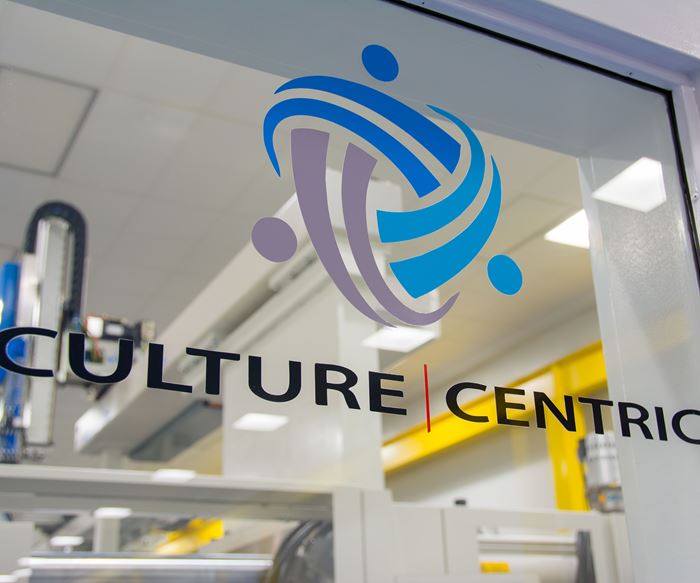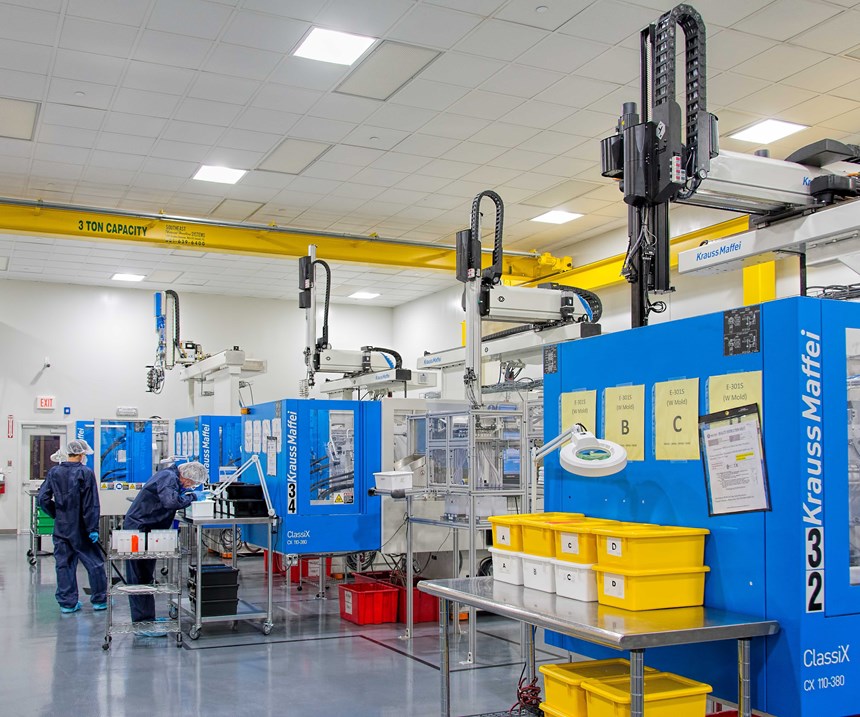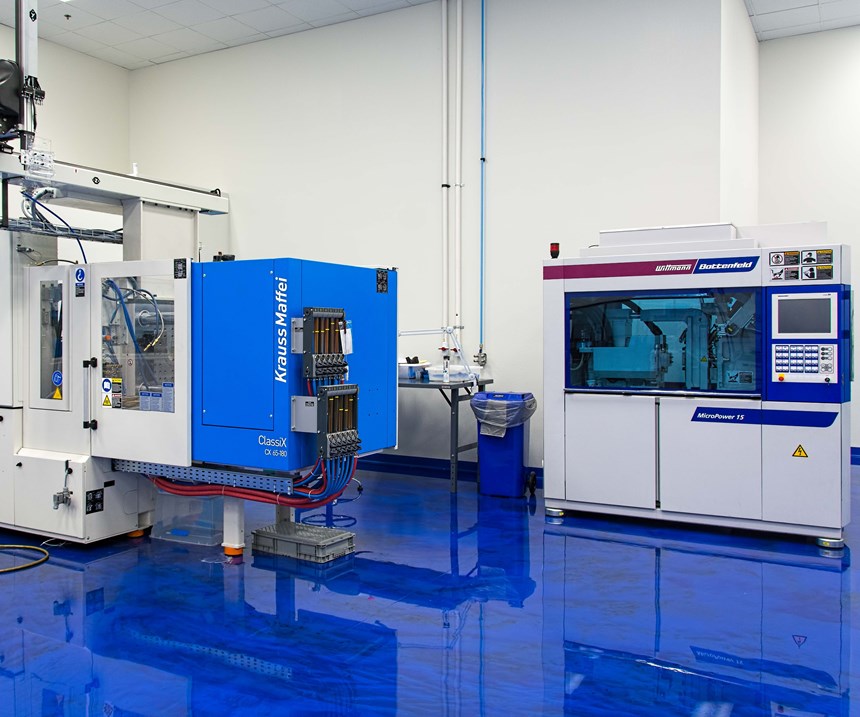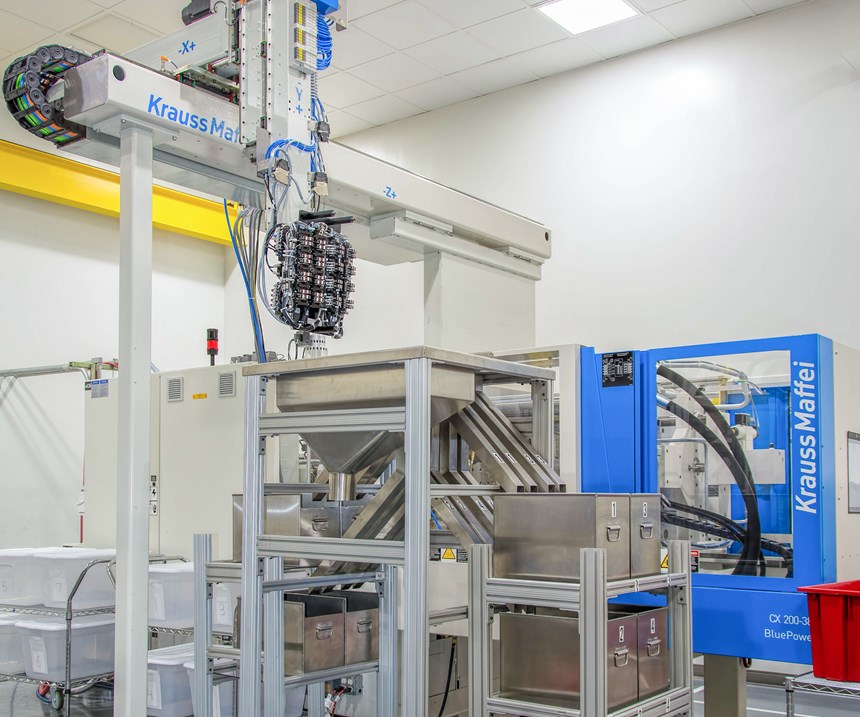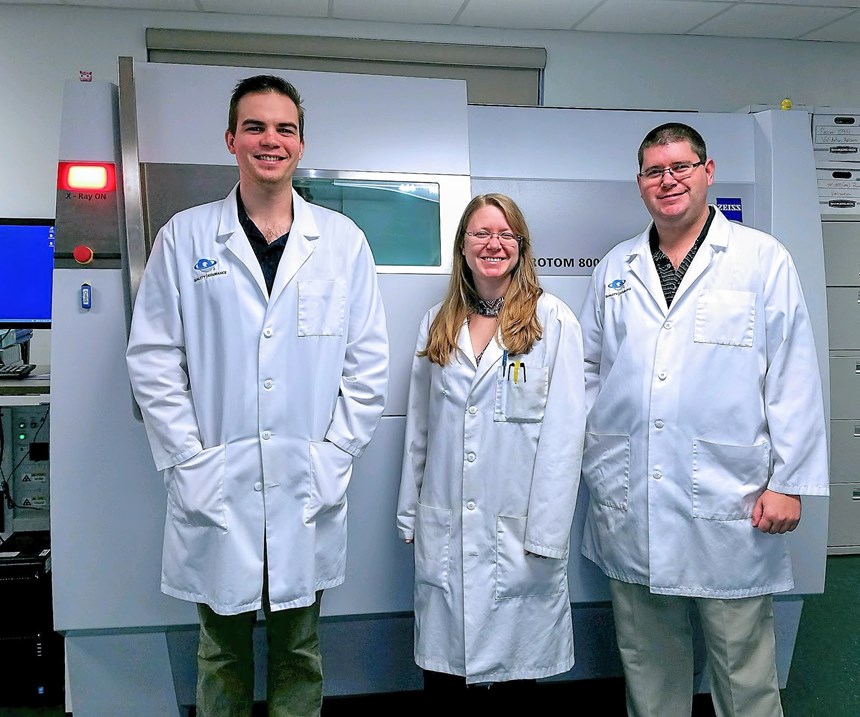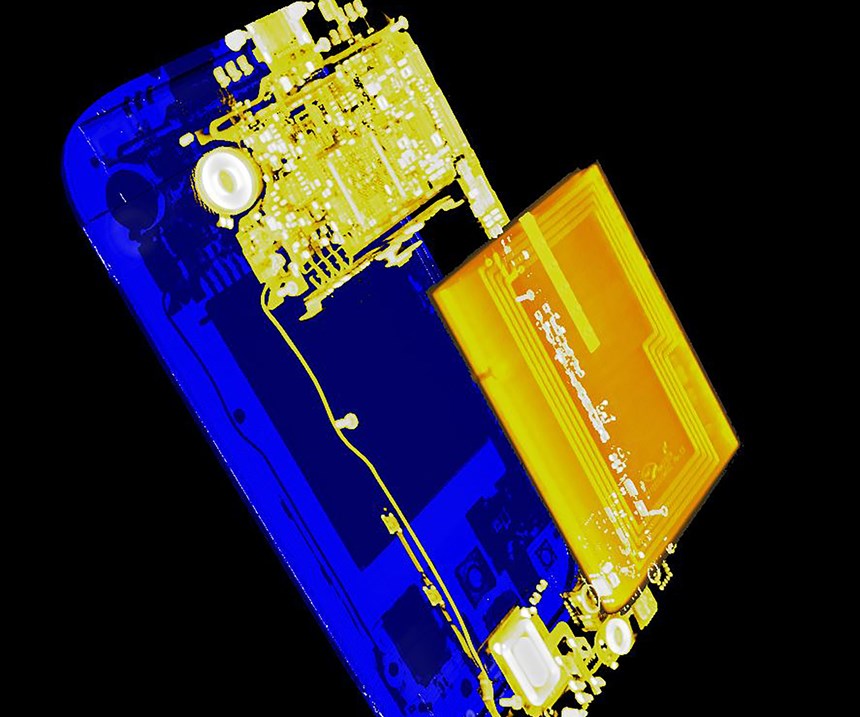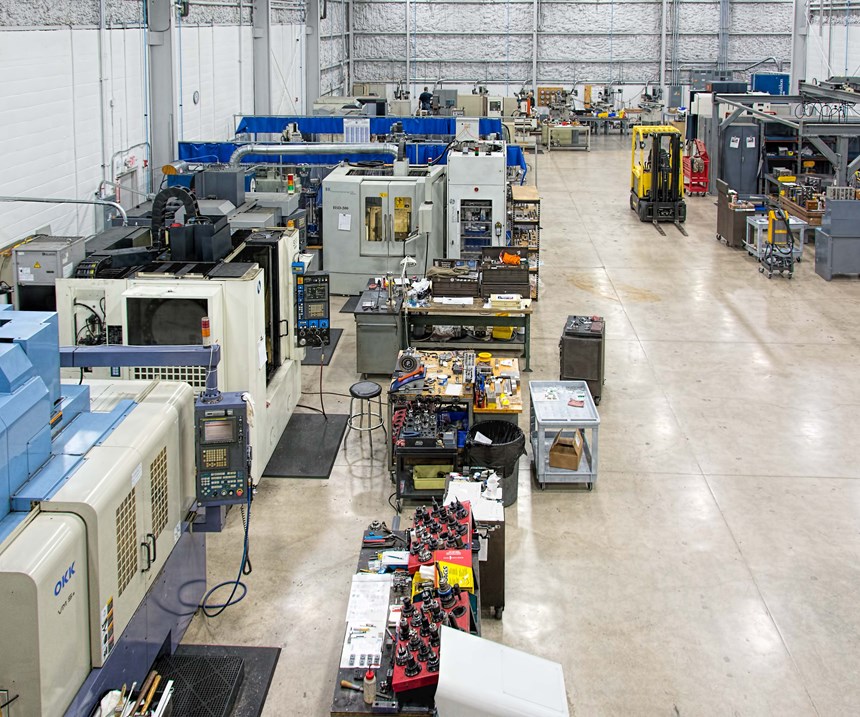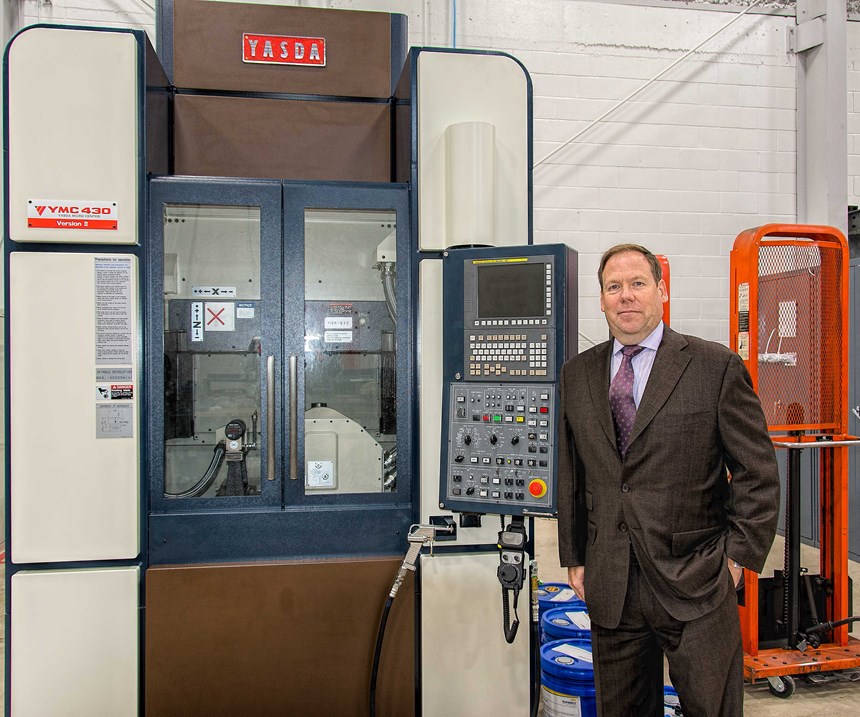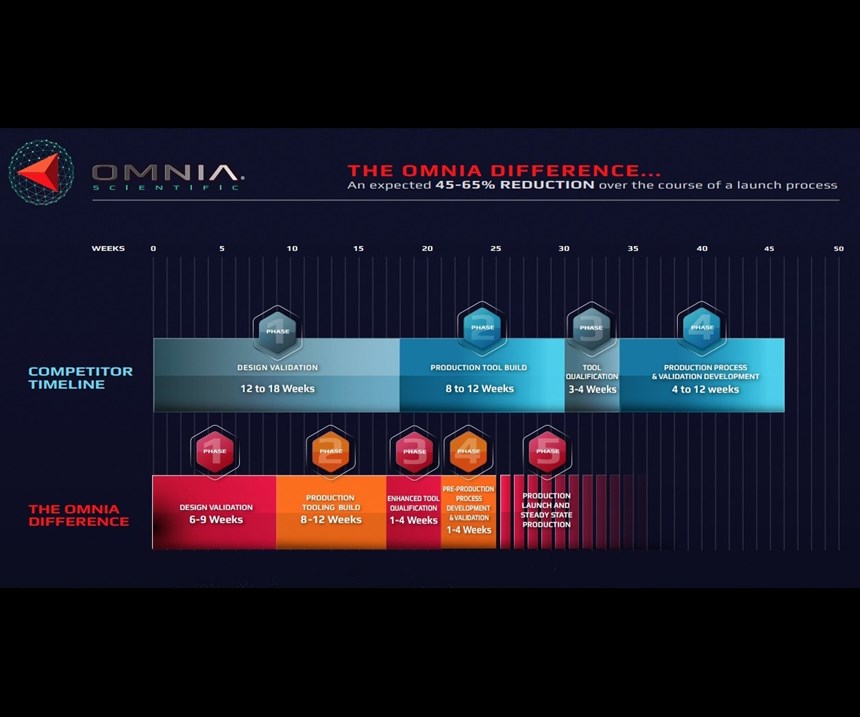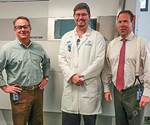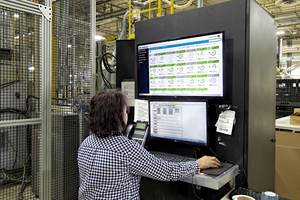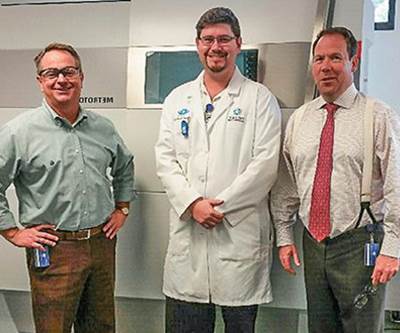How a commodity custom injection molder of cups, lids, and handles remade itself into a proponent of super-precise tooling, cutting-edge metrology, and paradigm-busting validation procedures for the most demanding customers in medical, aerospace, defense, and automotive industries is a story about big ideas and the passion to put them into practice. Ideas about what constitutes a company culture, what a custom molder’s business is really about, and what can make plastics manufacturing into a “noble” calling.
Something of what makes Octex different from the norm is evident in talking with Brett Wigton, 32 years old, with two masters degrees in synthetic biology and computer science. His title is chief scientist: “I’m responsible for applied sciences, research, IT, and developmental technology throughout all Octex operating companies.” He also leads the company’s Office of Scientific Innovation, the advanced development arm and specialized research service for the group. “I conduct professional studies in material science, biological engineering, and mechanical engineering, and use science and technology in parallel to solve complex challenges for the medical, aerospace, and defense industries.” How many custom molders have such a job title or job description?
And how many molders have such an attitude toward what they do? Listen to John W. Hoskins, Octex president: “Quality is foundational; it’s who you are. We get hundreds of millions of chances every year to affect someone’s life through the parts and tools we make. We play a noble role—helping save someone’s life when they’re sick or undergoing heart surgery, for example. Because we did what we’re supposed to do. We strive to keep that feeling every day—it’s the key to our brand.”
“We get hundreds of millions
of chances every year to save
or improve someone’s life.”
REMOLDING A MOLDING COMPANY
Octex Group in Sarasota, Fla., started out as an injection molder in 1990, but today it is about a lot more than molding. It consists of three businesses with total revenues under $50 million: the Octex molding business, moldmaker Choice Tool & Mold, and metrology services provider Omnia Scientific.
The transformation started four or five years ago, in a series of conversations between Octex CEO Jim Westman, who bought the molding company in 2009, and Hoskins, who had 30 years’ experience in plastics injection molding, extrusion, and thermoforming. He “grew up in plastics,” in a family business that started in 1918 to make buggy awnings and got into plastics in the 1950s. He sold that business in 2000 and went on to senior positions in consulting and managing other molding, moldmaking, and plastics materials companies.
Hoskins joined Octex in 2014 as executive v.p. and became president last June. He and Westman began to implement the plans they had discussed on how to change the company, which served mostly consumer and industrial customers, to one focused on medical, aerospace, and defense industries. But they had even bigger ambitions, as Hoskins puts it, “to push the edges of technology, move the market forward, do what others can’t do or won’t do.”
Just four years later, Octex Group’s business is about 75% medical/pharmaceutical devices and disposables, 1-2% aerospace/defense, and 23% consumer/industrial. This business transformation resulted from a thorough overhaul of the firm’s physical plant and equipment, and injection of a whole new culture.
Over the last five years, Octex invested more than $10 million in numerous upgrades and additions. It acquired a 20-year-old moldmaker, Choice Tool & Mold of Largo, Fla., and relocated it to a 15,000-ft2 former storage building on Octex’s 10-acre grounds in Sarasota.
Octex renovated the building and upgraded the tooling operation with state-of-the-art equipment (details below).
In addition, Octex purchased a top-of-the-line CT scanner and other sophisticated metrology equipment for what became Omnia Scientific. Octex also made major investments in IT systems, ERP systems, and a central supercomputer data hub. And the last eight months have seen a total renovation of the main building (70,000 ft2) with new floors, LED lighting, and major expansion of clean-room and white-room areas. Noting the shiny new floors throughout the molding areas, Hoskins says, “The whole place looks like a big operating room.”
In fact, the whole 30,000-ft2 manufacturing area in the main building has been upgraded in terms of cleanliness. The former 4000-ft2 Class 8 clean room has been expanded to 5000-6000 ft2 (containing five injection presses), while the rest of the building’s manufacturing area is a Class 8 white room. They have the same air quality, except that the white-room area lacks HEPA filtration and positive air pressure. But all areas are operated under the same FDA GMP standards—e.g., gowns, caps, and measuring particulate counts to 5 microns. The facility has the flexibility to segregate and upgrade another 4000 ft2 of white-room space to a clean room. Also, modular, temporary clean rooms can be erected around machines in the white-room area, if needed.
Octex also upgraded its injection machinery stock, retiring some older presses used to mold cups, etc., and bringing in new machines in several phases. The current line-up includes 25-35 injection machines (the population is still in flux) of 15 to 400 tons. Six new presses arrived in the past year—two 55-ton Engel presses and four KraussMaffei models (65 to 200 tons) of the new CX series, “with all the bells and whistles,” Hoskins says, including extra valves and switches and a gas accumulator. Octex also bought extra injection barrels in different sizes for the Engel and KM machines. “These give us added flexibility. We can swap barrels in 45 min,” Hoskins explains.
In 2015, Octex also added a Wittmann Battenfeld MicroPower 15-metric-ton, all-electric micromolding system, one of just a handful of such machines in the world. It has shot sizes down to 0.05 g and can mold parts as small as 0.0008 g with micro and “near-nano” feature capability. It is molding PEEK parts in the 0.02 g range. The entire machine is a Class 5 & 6 clean room with integrated automation and inspection capabilities. Micro parts are a new business direction for Octex, one that Hoskins expects will grow, though it will require additional parallel investments in micro tooling capabilities.
Several more machine purchases are planned, including an Engel two-shot press, a vertical machine, and larger sizes beyond 500 tons. Four new Engel and KM presses are due for installation (and four more are planned) in Launch Center 34, a white room to be dedicated to a demonstration facility for the company’s new quick-launch program, called Launchpad (discussed below). The machine builders will use this as a demo area to show other customers their newest machines, Hoskins says.
Other upgrades coming soon include new Novatec blenders and dryers, as well as a Frigel central cooling system.
Octex is also investing in automation. While most machines already are equipped with Cartesian robots (some able to heft up to 80 lb), a new cell will have two six-axis articulated robots serving two side-by-side presses to laser mark, assemble, test, and box parts. Already in operation is a medical cell in which the end-of-arm tooling (EOAT) for the Cartesian robot cost a whopping $100,000. It is designed to demold 32 delicate medical parts in 2.5 sec and is equipped with laser and optical sensors for good/bad part detection and for mold protection. Sophisticated controls are necessary to guide removal of groups of parts from multiple angles. The cavities are arranged in vertical rows round a convex curve, so each row is at an angle to the next.
The robot deposits the parts in a home-made device with multiple chutes to achieve cavity separation for quality control. This replaces manual sorting and saves 30 sec per cycle and the need for an operator. “That’s what Lean means to us—eliminating whole processes,” remarks Wigton.
“We don’t ‘think
outside the box’—
there is no box.”
CULTURE IS KING
According to Wigton, all the new hardware and facilities upgrades would be useless without one additional ingredient. “Culture is the most important part of our business,” he asserts.
“Our culture comes down to three words,” Hoskins explains:
• “ Engage: Always question things; be proactive—don’t wait for the customer to come to you.
• “ Innovate: Take hold of new, fresh ideas; embrace nascent cutting-edge technologies.
• “ Evolve: Embrace new partnerships, envision the world you want, and make it so.
“There’s a lot of misunderstanding of what culture really means. People say, ‘We have a culture of continuous improvement.’ We say that is a byproduct of a company’s culture, not the culture itself.”
BIG AMBITIONS
“Our goal is to offer the ultimate in high-precision, high-cavitation tooling,” proclaims Hoskins. Choice Tool is pursuing that ambition in a renovated building with a 32-ft ceiling, new LED lighting, and an engineering area elevated above the production floor—“so the engineers can keep an eye on things,” Hoskins notes.
The tooling operation employs 15 to 20 people, out of about 100 for the whole Octex group. Octex had a much smaller toolmaking capability before integrating the Choice Tool operation. New state-of-the-art equipment is designed to attract medical and aerospace customers. That includes what Hoskins calls “the most precise, high-speed, five-axis machining center you can buy,” a Yasda system that offers precision to a 20-millionth of an inch on all axes.
That one machine alone costs over $500,000. Plans are to add a robotic loader and a three-axis Yasda system. That will constitute the plant’s “hard-milling” section (capable of milling hardened steel). In coming years, Hoskins aims to add a duplicate of that entire cell. Meanwhile, a new wire EDM machine will arrive soon (the first of a planned three or four); and a new horizontal milling machine will replace several older Bridgeport machines. It will be automated so that it can be loaded up with two days’ work and run unattended. The facility also has a CNC lathe. Choice Tool is occupied 60-70% with outside tooling business and builds only about 30% of Octex’s molds. One thing that stands out from its competition is that Choice Tool offers a 3-million-shot warranty (as compared with the usual 1 million shots) for jobs that Octex molds in-house. Choice Tool has experimented with 3D-printed plastic molds for prototyping. Octex has a Stratasys Objet 30 inkjet-style 3D printer, which it also uses to make robot EOAT, jigs, fixtures, and support structures. Octex is interested in using 3D printing to make plastic production parts, but this requires work on establishing parameters for certifying such parts, Wigton notes.
Choice Tool is involved in projects designed to drastically accelerate the tool development and qualification process. One element of that effort is more than three years of ongoing R&D on a “hybrid” manufacturing process for tooling that involves both additive manufacturing laser sintering of powdered metal—and high-speed machining to final dimensions. Some production tooling has already been built with different variants of this method.
More immediately important to shortening the timeline for tool development is Octex’s implementation of world-class metrology facilities at Omnia Scientific. The heart of that operation is the Zeiss Metrotom 800 CT scanner, an x-ray imaging device that “provides the most accurate resolution and is extremely fast,” according to Thomas Schuler, director of Omnia. This machine costs between $500,000 and $750,000. Octex believes it was the first molder of its size to have such a system (see Apr. ’16 Processor’s Edge).
According to Schuler, it can provide 50,000 measurements in 65-85% less time than conventional CMMs. Beyond that, it can visualize internal geometry nondestructively and can reveal internal porosity, weld lines, and glass-fiber distribution and orientation. Requiring no fixturing, entire assemblies can be measured and then separated or “exploded” in animated views. Schuler expects the CT scanner to add value to Octex’s new micromolding business. That’s because the machine registers 2 million voxels (3D pixels) per scan, regardless of the size of the part, which translates into much greater resolution on micro parts.
“What’s unusual about Omnia,” Schuler adds, “is that it’s a metrology business run by plastics processors. Anyone can report measurements, but they can’t tell you why the measurements are the way they are.”
He cites the example of parts from a 32-cavity hot-runner system that was unbalanced. Omnia was able to measure all 32 parts and overlay each part on a CAD model to determine the variances, and then place those parts on a CAD image of the mold to help understand how the runner system needed to be balanced.
Two case histories illustrate how the CT scanner has helped Octex penetrate the medical molding business. In one case, resorbable surgical implants were cracking, and the OEM spent three years unsuccessfully trying to find the root cause. “With the CT scanner, we solved it in two weeks,” Wigton says. “It was a processing issue.”
In a second case, a biomedical storage medium required ability to withstand immersion in liquid nitrogen for up to 10 years while retaining a hermetic seal. The OEM could not find a way to make the product pass this test. According to Wigton, “We solved it with the help of the CT scanner, and now this is one of our biggest customers.”
Omnia Scientific’s staff of fewer than half a dozen has other remarkable metrology resources. Two Instant Measuring Machines from Keyence Corp. of America use optical sensing and ring illumination to measure up to 99 critical dimensions in 3 sec with accuracy of ±2 μ. 3D microscopes are also used for production QC.
Omnia is looking into inspection capabilities that even go beyond that of the CT scanner. One is transmission electron microscopy, to look for porosity in micro parts. Another is XRAD, which Hoskins describes as a hybrid of CT scanning and x-ray microscopy. It has the advantage of revealing surface morphology, unlike CT scanning alone.
Fast and accurate measurements are only half the story: Omnia Scientific supports that ability with a super-fast, high-capacity IT infrastructure. This was Wigton’s first project; he completely redesigned the company IT capability to acquire and store all the data from all the Octex operations and to provide data security. He installed a fiber-optic data superhighway to transfer data from all the plant’s machines to a supercluster. The data are encrypted for storage on-site and backed up in the cloud to a redundant network of seven different data centers.
Wigton says his network can handle transfers of up to 250 terabytes (1 TB = 1024 GB), which he claims is equivalent to the capacity of a national cell-phone carrier. Why so much capacity? One CT scan can generate up to 10 GB of data, and one mold might require scans of up to 32 parts. To illustrate what that means, Wigton says, “To put 10 GB on a flash drive takes 10 min. To download that data to a central computer takes another 10 min. Multiply that by 32. My system can do a direct transfer in 2 min per scan, with no USB drive.”
This central computer handles more than metrology data. It will be linked to the firm’s IQMS production monitoring system and to process data from the injection-machine controls. “Every keystroke is monitored by the central computer,” Wigton says. “And I can shut down anything in the plant from my phone in 30 sec, if necessary.”
“We have competitors in molding, tooling,
metrology—but not all three together.”
REAL-TIME FIRST-ARTICLE INSPECTION
World-class metrology and a high-capacity data network add up to what Hoskins considers to be his firm’s key strategic advantage: “real-time first-article inspection.” This requires some explanation:
A CT scan takes 1 hr for each of 32 cavities: That’s 32 hr to collect the data. According to Wigton, it then usually takes weeks more to process the “point cloud” of data and resolve it into dimensional measurements. “That’s weeks to obtain usable data—versus 5 minutes for us.” He says there was no software available to do this, so Octex wrote its own. So “real-time” in this case means, “As fast as we can scan, we can get usable data. We can load all 32 point clouds and 10 sec later, we start getting measurements.”
This is the key to competitiveness for Octex. Says Hoskins, “I can’t fight somebody who has nine plants and 2000 machines. But I can do things nobody else can. Others just want the manufacturing part; they see validation as a nuisance. For us it’s a core strategy.”
Adds Wigton, “We have competitors in molding, in metrology, in tooling. But not all three together. That means we can do all the qualifications here, so the customer gets into production faster.”
“And what do customers really want?” asks Hoskins. “To get new, innovative products to market faster than ever before.”
“What do customers really want? To get new,
innovative products to market faster than ever before.”
ACCELERATED LAUNCH PROCESS
These synergistic capabilities—tooling, molding, and metrology—have led Octex Group to propose a new paradigm for product launches. Called Launchpad, Octex claims it can offer 40-90% reduction in tool-build time, 45-75% reduction in tool cost, and 60% reduction in time to market.
As shown in the accompanying graphic, the usual process can easily take 45 weeks from the start of design validation through production tool build, tool qualification, and production process and validation development. With the new process, spearheaded by Omnia Scientific, that process can be collapsed to 30-35 weeks.
The difference, Hoskins explains, is that the different phases of the launch process are typically handled by different groups with different cultures—resulting in “loss of fidelity,” as Hoskins puts it. “But we have all the pieces of the puzzle under our roof. So we can conduct different phases concurrently. Our goal is to compress the usual eight- to 12-week tool-build process into just three weeks. This is what OEMs have been begging for.”
Octex plans to introduce Launchpad in May at NPE2018 in Orlando, Fla.
Related Content
Impacts of Auto’s Switch to Sustainability
Of all the trends you can see at NPE2024, this one is BIG. Not only is the auto industry transitioning to electrification but there are concerted efforts to modify the materials used, especially polymers, for interior applications.
Read MoreInjection Molded Enclosures Plug into Potential Electric Vehicle Battery Applications
In partnership with material suppliers, Engel is proving out injection molded thermoplastic-based concepts for electric vehicle battery housings, utilizing production tools and dedicated machines at its large press factory in St. Valentin, Austria.
Read MoreCarbon Fiber Reinforced Nylon 12 for Injection Molding
CRP Technology’s new composite is 100% recycled from Windform XT 2.0 IMG industrial 3D printing material.
Read MoreNew CRM Streamlines Quoting for Automotive Molder
Eliminating the need to contact each supplier for every individual quote, a new CRM for automotive supplier Axiom Group tracks past quotes as well as industry history to generate fast, reliable RFQs and more.
Read MoreRead Next
Savvy Molder Willing To Share Its Smarts
OCTEX adds advanced metrology technology to brand-new lab, and will make it available to other molders.
Read MoreMaking the Circular Economy a Reality
Driven by brand owner demands and new worldwide legislation, the entire supply chain is working toward the shift to circularity, with some evidence the circular economy has already begun.
Read MoreFor PLASTICS' CEO Seaholm, NPE to Shine Light on Sustainability Successes
With advocacy, communication and sustainability as three main pillars, Seaholm leads a trade association to NPE that ‘is more active today than we have ever been.’
Read More


